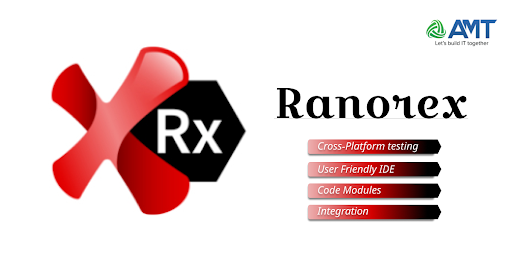Ranorex is a popular test automation tool primarily used for automating user interface (UI) testing of desktop, web, and mobile applications. It is designed to help software testers and developers automate repetitive and manual testing tasks, thus improving the efficiency and accuracy of the testing process. Here are some key features and aspects of Ranorex:
- Cross-Platform Testing: Ranorex supports the automation of applications on various platforms, including Windows desktop, web applications (across different browsers), and mobile applications (iOS and Android).
- User-Friendly IDE: Ranorex provides a user-friendly integrated development environment (IDE) that allows users to create and manage automated test scripts using a combination of code and a visual test automation editor. This makes it accessible to both testers and developers.
- Record and Playback: Ranorex offers a recording feature that allows testers to record their interactions with the application, such as clicking buttons, filling out forms, and navigating menus. These recorded actions can then be played back as automated test scripts.
- Code Modules: Testers can extend their automation scripts with code modules written in C# or VB.NET, giving them more control and flexibility to handle complex test scenarios.
- Data-Driven Testing: Ranorex supports data-driven testing, allowing testers to use different sets of test data to execute the same test script with various input values, making it easier to cover a wide range of test cases.
- Test Reporting and Analysis: It generates detailed test reports that include screenshots and logs, making it easier to identify and analyze issues during test execution.
- Integration: Ranorex can be integrated with various test management and continuous integration (CI) tools, such as Jenkins, TeamCity, and TestRail, to facilitate seamless test automation within the software development lifecycle.
- Cross-Browser Testing: It supports testing web applications across multiple browsers, ensuring compatibility and consistent behavior across different browser platforms.
- Object Recognition: Ranorex uses a powerful algorithm for object recognition, allowing it to locate and interact with UI elements even when they change dynamically.
- Community and Support: Ranorex has an active user community, and the company provides documentation, tutorials, and support resources to help users get started and troubleshoot issues.
- License Cost: Ranorex is a commercial tool, and it offers a free trial version. Pricing typically depends on the number of licenses and the level of support required.
Ranorex is a versatile tool that can be used for various types of testing, including regression testing, smoke testing, and functional testing. It is especially useful for organizations that require automated testing of applications on multiple platforms and browsers.
Here are some additional details and considerations about Ranorex:
- Keyword-Driven Testing: Ranorex supports keyword-driven testing, which allows testers to create test scripts using a set of predefined keywords. This approach simplifies test script creation and maintenance, making it more accessible to non-technical team members.
- Test Automation Framework: Ranorex provides the flexibility to create custom test automation frameworks, allowing organizations to establish best practices and standards for test automation across projects.
- Cross-Device Testing: For mobile application testing, Ranorex supports testing on various devices and screen resolutions, making it suitable for ensuring mobile app compatibility across different devices.
- Parallel Test Execution: Test suites can be configured to run tests in parallel, which can significantly reduce the overall test execution time, especially when dealing with a large number of test cases.
- Object Repository: Ranorex uses an object repository to store information about UI elements in the application under test. This makes it easy to manage and update object properties and locate elements in your tests.
- Support for Desktop Technologies: Ranorex supports testing of Windows-based desktop applications, making it valuable for organizations that develop software for the Windows platform.
- Continuous Testing: Integrating Ranorex with CI/CD pipelines allows for continuous testing, enabling automatic test execution on code commits, ensuring early detection of issues in the development process.
- Test Maintenance: Like any test automation tool, maintaining test scripts as the application evolves is an important consideration. Testers need to update scripts to accommodate changes in the application’s UI or functionality.
- Training and Learning Curve: While Ranorex is user-friendly, it may still require some training for testers who are new to test automation. Familiarity with C# or VB.NET can be beneficial for more advanced automation tasks.
- License Flexibility: Ranorex offers various licensing options, including node-locked and floating licenses, to accommodate the needs of different organizations and teams.
- Community and Resources: The Ranorex community is active and can be a valuable resource for getting answers to questions and sharing best practices. The Ranorex website also provides documentation, webinars, and tutorials.
- Test Maintenance: As with any test automation tool, maintaining test scripts as the application evolves is important. Testers need to update scripts to accommodate changes in the application’s UI or functionality.
- Performance Testing: While Ranorex primarily focuses on functional and regression testing, it may not be the best tool for performance testing. Organizations looking for performance testing may need to integrate Ranorex with specialized performance testing tools.
Ranorex is a versatile tool that can be a valuable asset for organizations looking to automate their testing processes, improve software quality, and accelerate their software development lifecycle. However, as with any test automation tool, it’s essential to carefully plan your automation strategy, consider your specific testing requirements, and invest in training and support to maximize its benefits.
Watch this space for more updates on the latest trends in Technology.
